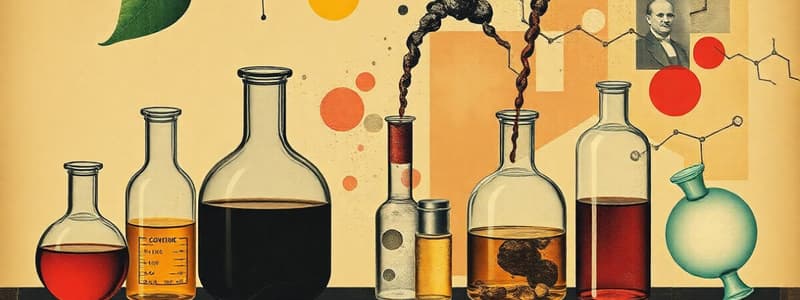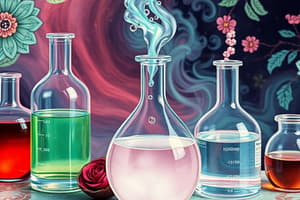Podcast
Questions and Answers
Which statement accurately describes the formation of ions and the resulting bond in an ionic compound?
Which statement accurately describes the formation of ions and the resulting bond in an ionic compound?
- Atoms lose or gain electrons to form ions, resulting in an ionic bond. (correct)
- Atoms lose or gain neutrons to form ions, resulting in an ionic bond.
- Atoms lose or gain protons to form ions, resulting in an ionic bond.
- Atoms share electrons to form ions, resulting in a covalent bond.
Consider two elements, X and Y, located in the same group of the periodic table. Element X has a smaller atomic number than element Y. How would you expect their reactivity to differ if they are both alkali metals?
Consider two elements, X and Y, located in the same group of the periodic table. Element X has a smaller atomic number than element Y. How would you expect their reactivity to differ if they are both alkali metals?
- Element Y will be less reactive due to its increased number of electron shells shielding the valence electron.
- Element Y will be more reactive because its outer electron is further from the nucleus and easier to remove. (correct)
- Element X will be more reactive because it has a greater tendency to lose its outer electron.
- Element X and Y will have similar reactivity because they have the same number of outer shell electrons.
During the extraction of a metal from its ore, a redox reaction takes place. Which of the following correctly identifies the processes of oxidation and reduction in terms of electron transfer?
During the extraction of a metal from its ore, a redox reaction takes place. Which of the following correctly identifies the processes of oxidation and reduction in terms of electron transfer?
- Oxidation involves the gain of oxygen, and reduction involves the loss of oxygen.
- Oxidation involves a decrease in oxidation number, and reduction involves an increase in oxidation number.
- Oxidation is the gain of electrons, and reduction is the loss of electrons.
- Oxidation is the loss of electrons, and reduction is the gain of electrons. (correct)
A chemical reaction is found to release heat into the surroundings. Which statement below correctly describes this reaction in terms of energy change and provides a real world example?
A chemical reaction is found to release heat into the surroundings. Which statement below correctly describes this reaction in terms of energy change and provides a real world example?
Consider a reaction where reactants are in the gaseous state. Which of the following changes would likely increase the rate of the reaction, assuming all other factors remain constant?
Consider a reaction where reactants are in the gaseous state. Which of the following changes would likely increase the rate of the reaction, assuming all other factors remain constant?
An element has an electronic configuration of 2,8,6. What type of ion will this element most likely form, and to which group in the periodic table does it belong?
An element has an electronic configuration of 2,8,6. What type of ion will this element most likely form, and to which group in the periodic table does it belong?
Which of the following options correctly explains why metals are good conductors of electricity?
Which of the following options correctly explains why metals are good conductors of electricity?
Crude oil is separated into different fractions through fractional distillation. Which property is the primary basis for this separation?
Crude oil is separated into different fractions through fractional distillation. Which property is the primary basis for this separation?
Consider the Haber process, an industrial process used for the synthesis of ammonia ($NH_3$). Which of the following actions would increase the rate of ammonia production?
Consider the Haber process, an industrial process used for the synthesis of ammonia ($NH_3$). Which of the following actions would increase the rate of ammonia production?
How did the Earth's early atmosphere change over time, leading to the composition we observe today?
How did the Earth's early atmosphere change over time, leading to the composition we observe today?
Which of the following metal extraction methods is best suited for a highly reactive metal like potassium?
Which of the following metal extraction methods is best suited for a highly reactive metal like potassium?
What is the primary difference between a thermoplastic and a thermosetting polymer?
What is the primary difference between a thermoplastic and a thermosetting polymer?
A student performs an experiment to determine the percentage yield of a reaction. They theoretically expect to produce 25.0g of product but obtain only 20.0g. What is the percentage yield of the reaction?
A student performs an experiment to determine the percentage yield of a reaction. They theoretically expect to produce 25.0g of product but obtain only 20.0g. What is the percentage yield of the reaction?
Consider the reaction between zinc metal and copper(II) sulfate solution: $Zn(s) + CuSO_4(aq) \rightarrow ZnSO_4(aq) + Cu(s)$. Which of the following statements is correct regarding the electron transfer in this reaction?
Consider the reaction between zinc metal and copper(II) sulfate solution: $Zn(s) + CuSO_4(aq) \rightarrow ZnSO_4(aq) + Cu(s)$. Which of the following statements is correct regarding the electron transfer in this reaction?
A solution has a pH of 3. What does this indicate about the solution, and what type of substance would neutralize it?
A solution has a pH of 3. What does this indicate about the solution, and what type of substance would neutralize it?
Which statement accurately describes the role of a catalyst in a chemical reaction?
Which statement accurately describes the role of a catalyst in a chemical reaction?
What is the key structural difference between an alkane and an alkene?
What is the key structural difference between an alkane and an alkene?
In the context of chemical reactions, what is the significance of activation energy?
In the context of chemical reactions, what is the significance of activation energy?
What is the purpose of 'cracking' in the refining of crude oil?
What is the purpose of 'cracking' in the refining of crude oil?
Consider the neutralization reaction between a strong acid and a strong base. What would be the expected pH of the resulting solution at the equivalence point?
Consider the neutralization reaction between a strong acid and a strong base. What would be the expected pH of the resulting solution at the equivalence point?
Flashcards
What are isotopes?
What are isotopes?
Atoms of the same element with different numbers of neutrons.
What are cations?
What are cations?
Ions formed when atoms lose electrons, resulting in a positive charge.
What forms ions?
What forms ions?
Atoms gain or lose electrons creating charged particles.
What are ionic bonds?
What are ionic bonds?
Signup and view all the flashcards
What are covalent bonds?
What are covalent bonds?
Signup and view all the flashcards
What is a group?
What is a group?
Signup and view all the flashcards
How are elements arranged on The Periodic Table?
How are elements arranged on The Periodic Table?
Signup and view all the flashcards
Why do elements in the same group share similar chemical properties?
Why do elements in the same group share similar chemical properties?
Signup and view all the flashcards
What are alkali metals?
What are alkali metals?
Signup and view all the flashcards
What are halogens?
What are halogens?
Signup and view all the flashcards
What are noble gases?
What are noble gases?
Signup and view all the flashcards
What is crude oil?
What is crude oil?
Signup and view all the flashcards
What is fractional distillation?
What is fractional distillation?
Signup and view all the flashcards
What are exothermic reactions?
What are exothermic reactions?
Signup and view all the flashcards
What is activation energy?
What is activation energy?
Signup and view all the flashcards
What is bioleaching?
What is bioleaching?
Signup and view all the flashcards
What is phytomining?
What is phytomining?
Signup and view all the flashcards
What are polymers?
What are polymers?
Signup and view all the flashcards
What is relative atomic mass (Ar)?
What is relative atomic mass (Ar)?
Signup and view all the flashcards
What is relative formula mass (Mr)?
What is relative formula mass (Mr)?
Signup and view all the flashcards
Study Notes
- Study notes for Chemistry topics: Atomic Structure, Forming Ions, Bonding Basics, The Periodic Table, Crude Oil and Fuel, Energy Changes, Chemistry of the Atmosphere, Extracting Metals, Alternative Extraction Methods, Materials, Calculations, Reactivity of Metals, Acids, Rates of Reaction, Organic Chemistry, Rate and Extent of Chemical Change, Chemical Changes, Quantitative Chemistry.
Atomic Structure
- Atoms are composed of protons, neutrons, and electrons.
- Protons have a positive charge, electrons have a negative charge, and neutrons are neutral.
- The number of protons determines the element.
- The number of protons equals the number of electrons in a neutral atom.
- The mass number is the total number of protons and neutrons in an atom.
- Isotopes are atoms of the same element with different numbers of neutrons.
Forming Ions
- Ions are formed when atoms gain or lose electrons.
- Positive ions (cations) are formed when atoms lose electrons.
- Negative ions (anions) are formed when atoms gain electrons.
- Ionic compounds are formed through the electrostatic attraction between oppositely charged ions.
Bonding Basics
- Ionic bonds involve the transfer of electrons between atoms.
- Covalent bonds involve the sharing of electrons between atoms.
- Metallic bonds involve the delocalization of electrons within a metal lattice.
- The type of bonding affects the physical properties of a substance, such as melting point and conductivity.
- Dot and cross diagrams are used to represent bonding in molecules.
The Periodic Table
- Elements are arranged in order of increasing atomic number.
- Elements in the same group have similar chemical properties due to having the same number of outer shell electrons.
- Metals are on the left side and non-metals are on the right side.
- Group 1 are the alkali metals.
- Group 7 are the halogens.
- Group 0 are the noble gases.
- Transition metals are located in the central block of the periodic table.
Crude Oil and Fuel
- Crude oil is a complex mixture of hydrocarbons.
- Fractional distillation separates crude oil into fractions based on boiling point.
- Shorter hydrocarbon chains have lower boiling points and are more flammable.
- Cracking breaks down larger hydrocarbons into smaller, more useful ones.
- Combustion of fuels releases energy.
- Burning hydrocarbon fuels produces carbon dioxide and water.
Energy Changes
- Exothermic reactions release energy, resulting in a temperature increase.
- Endothermic reactions absorb energy, resulting in a temperature decrease.
- Activation energy is the minimum energy required for a reaction to occur.
- Catalysts lower the activation energy, speeding up the reaction.
- Energy change is calculated using bond energies: energy change = sum of bonds broken - sum of bonds formed.
Chemistry of the Atmosphere
- The early atmosphere was mainly carbon dioxide.
- Over time, carbon dioxide levels decreased due to the formation of sedimentary rocks and the evolution of photosynthetic organisms.
- The current atmosphere is composed mainly of nitrogen and oxygen.
- Greenhouse gases trap heat and contribute to global warming.
- Air pollution is caused by the release of harmful substances into the atmosphere.
Extracting Metals
- Metals are extracted from their ores through various methods.
- Electrolysis is used to extract reactive metals.
- Reduction with carbon is used to extract less reactive metals.
- Bioleaching and phytomining are alternative methods of extraction.
Alternative Extraction Methods
- Bioleaching uses bacteria to extract metals from low-grade ores.
- Phytomining uses plants to absorb metals from the soil.
Materials
- Polymers are large molecules made up of repeating units (monomers).
- Thermoplastics can be repeatedly softened and reshaped.
- Thermosetting polymers are rigid and do not soften upon heating.
- Composites are materials made from two or more different materials.
- Ceramics are non-metallic solids with high melting points.
- The properties of materials depend on their structure and bonding.
- Nanomaterials have unique properties due to their small size.
Calculations
- Relative atomic mass (Ar) is the average mass of an atom of an element compared to 1/12th the mass of a carbon-12 atom.
- Relative formula mass (Mr) is the sum of the relative atomic masses of all the atoms in a formula.
- Moles = mass / Mr .
- Concentration = moles / volume.
- Percentage yield = (actual yield / theoretical yield) x 100.
- Atom economy = (Mr of desired product / Mr of all reactants) x 100.
Reactivity of Metals
- Metals react differently depending on their position in the reactivity series.
- Metals higher in the series displace metals lower in the series from their compounds.
- Oxidation is the loss of electrons.
- Reduction is the gain of electrons.
- Redox reactions involve both oxidation and reduction.
- Ionic equations show only the species that participate in a reaction.
- Half equations show the oxidation or reduction process separately.
Acids
- Acids have a pH less than 7.
- Alkalis have a pH greater than 7.
- Neutral substances have a pH of 7.
- Acids donate protons (H+ ions).
- Bases accept protons.
- Neutralization is the reaction between an acid and a base.
- Strong acids completely ionize in water.
- Weak acids partially ionize in water.
- Titration is used to determine the concentration of an acid or base.
Rates of Reaction
- The rate of a reaction is the change in concentration of reactants or products per unit time.
- Factors affecting reaction rate include temperature, concentration, surface area, and catalysts.
- Increasing the temperature increases the kinetic energy of particles, leading to more frequent and energetic collisions.
- Increasing the concentration increases the frequency of collisions.
- Increasing the surface area increases the number of particles available for reaction.
- Catalysts speed up reactions by providing an alternative reaction pathway with lower activation energy.
Organic Chemistry
- Organic chemistry is the study of carbon-containing compounds.
- Alkanes are saturated hydrocarbons with single bonds only.
- Alkenes are unsaturated hydrocarbons with at least one double bond.
- Alcohols contain the -OH functional group.
- Carboxylic acids contain the -COOH functional group.
- Polymers are large molecules made up of repeating units (monomers).
Rate and Extent of Chemical Change
Chemical Changes
Quantitative Chemistry
Studying That Suits You
Use AI to generate personalized quizzes and flashcards to suit your learning preferences.




